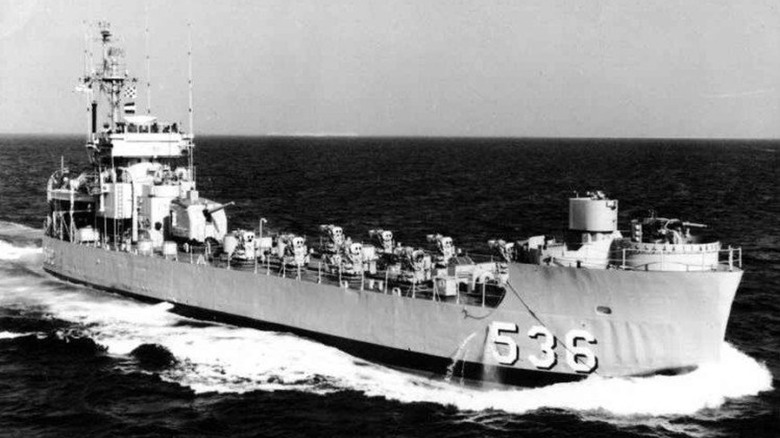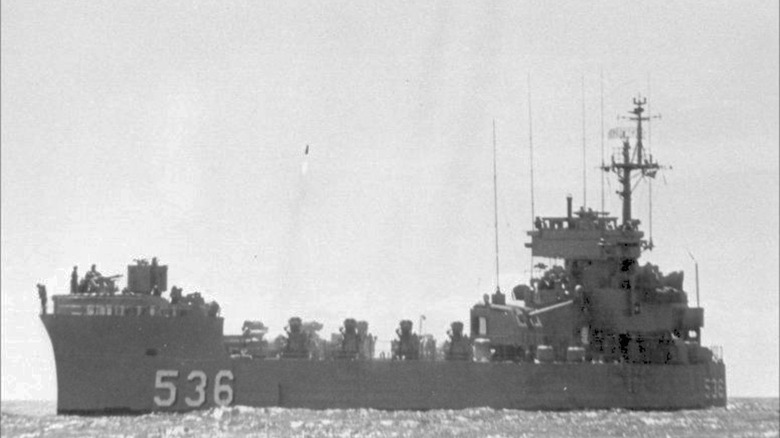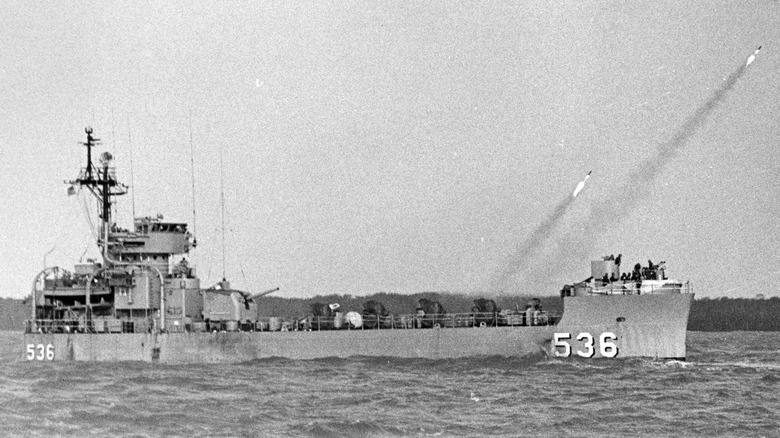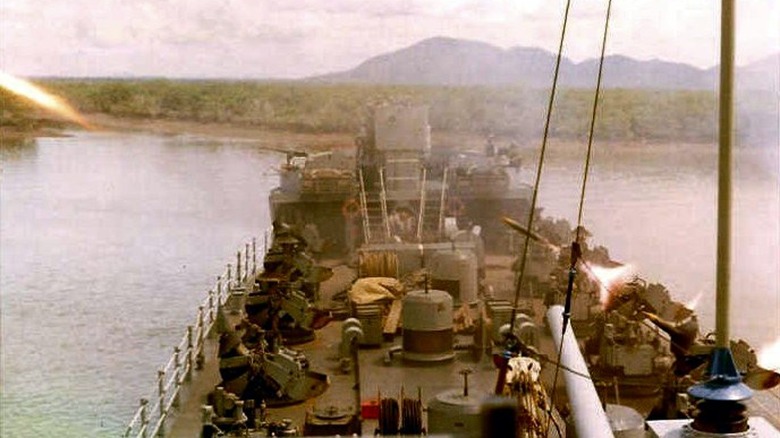The Fascinating History Of The USS White River Rocket Ship From 1945
The U.S. Navy has employed a variety of rocket delivery ships for decades now, so it's not unusual for a missile frigate, Ohio-class nuclear submarine, or other ship to fire off destructive Tomahawk Cruise Missiles or any of the U.S.' plethora of rocket munitions. But back during WWII, rocketry was just getting off the ground — pun intended.
The USS White River might not make it on the list of the most legendary World War II ships, but she was definitely unique and changed what was understood to be possible in naval warfare. For starters, the vessel wasn't commissioned until after WWII ended, so she was never going to participate in that conflict in the first place. Commissioned in 1945, White River began life as a Landing Ship Medium (Rocket), or LSMR-501-class ship, and over the course of the White River's 25-year service history, she saw a lot of action, though not initially.
The USS White River only sailed for around nine months before she was decommissioned in July 1946. She spent some time in Florida with the Atlantic Reserve Fleet before she was recommissioned in 1950 to take part in the Korean War. She went on to serve during the Vietnam War and was redesignated an Inshore Fire Support Ship (LFR-536) in January 1969. The following year, the USS White River was finally decommissioned, having earned two battle stars for operations throughout the Korean War and 10 campaign stars for service during the Vietnam War.
The USS White River was a floating artillery battery
The USS White River was initially commissioned as USS LSM(R)-536 and wouldn't receive her name until October 1955. In terms of size, the White River displaced up to 1,175 tons of seawater when fully loaded, measured just over 203 feet long, and operated via two General Motors diesel engines. These pushed the White River to a maximum speed of 13 knots (15 mph).
The ship's crew complement included six officers and 137 enlisted personnel, and she was heavily armored. The White River had a single dual-purpose gun mount, two twin 40mm gun mounts, four twin 20mm gun mounts, four 4.2" mortars, and 10 twin tube 5" Mk-102 rocket launchers. Additionally, the ship boasted armor on her most sensitive areas, including the conning station, radio room, pilot-house, radar plot, and rocket control room.
The White River was somewhat unique, having been converted from a landing craft into one capable of delivering rockets on targets far from shore. Essentially a floating artillery battery, she fired hundreds of thousands of rockets and mortars at enemy targets throughout her service life, helping the U.S. in its fights in Korea and Vietnam. The White River didn't carry troops to deliver to enemy beachheads, which gave her ample space to house thousands of rockets in the ship's hold. Because of her relatively light draft, she could move closer to shore and fire at targets outside the range of other larger vessels.
The USS White River brought unprecedented firepower
The USS White River wasn't the first rocket ship operated by the U.S. Navy, so it featured improvements over the previously used LSMR-188-class. For example, the weapon system on the LSMR-501-class ships allowed them to fire from various positions, whereas the LSMR-188-class ships could only fire in one direction because its launchers were welded in place.
The early rocket ships also required hours to reload the launch tubes, but ships like the USS White River didn't have this problem. Upgrades to the vessel included adding the newly-developed Mark 102 rocket launcher, which could fire multiple rounds within seconds. The weapon system was then automatically reloaded, abandoning the requirement to manually reload, enabling the launcher to fire around 30 rockets every minute. Since the ship boasted up to 10 of these systems, she could fire up to 300 rockets per minute.
Overall, the vessel could carry as many as 5,000 rockets on board, though this depended on the type of ordnance. The White River could fire four different types of rockets, with the longest range stretching 5.6 miles away. The Navy boasted the ship's performance, touting her as having the same amount of firepower as five destroyers. While that certainly wouldn't be an apt description today, back when the White River sailed, the comparison was apt.
The USS White River served in Korea and Vietnam
The USS White River finally saw action in 1951 while sailing along the coast of Korea in the Pacific Fleet. That said, she didn't enter the conflict zone until July 16, 1952 and went on to patrol the North Korean coastline. She remained in the area after the war ended and was renamed and returned to the U.S. in 1955. The following year, she was decommissioned a second time and placed into the Pacific Reserve Fleet housed in San Diego.
In 1965, the Navy once more called upon the White River, recommissioning her for action in Vietnam. In May 1966, she arrived and quickly engaged in combat, providing fire support for the South Vietnamese Army. She spent most of the war patrolling the Vietnamese coastline but also strayed into the waters of Cambodia in the Gulf of Thailand. Because she weighed comparatively little, the White River was able to sail up the Mekong River Delta, opening up her area of engagement further inshore.
The White River continued fighting throughout the Vietnam War, delivering rockets to unsuspecting Viet Cong and North Vietnamese Army regulars. She conducted her final mission in March 1970, having sailed 18 miles upriver to provide fire support for five hours to the tune of 2,526 rockets. After this, the White River had proven herself in combat but was at a technological disadvantage when compared to newer vessels. The Navy decommissioned her in 1970 and sold her for scrap.



